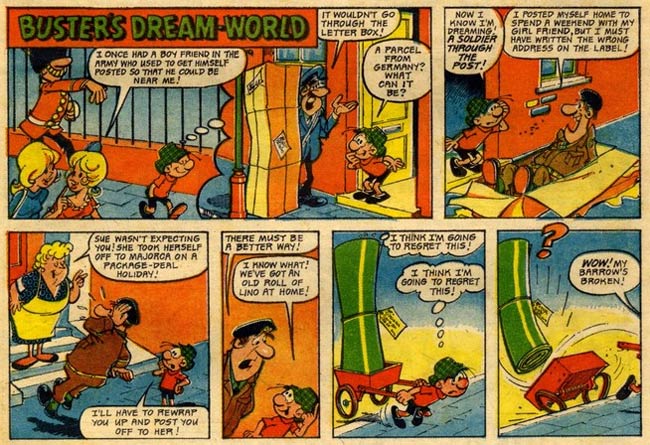'Marinili Gustavito'.
Ángel Nadal Quirch was a Spanish artist, who began his career in his home country as one of the classic artists of the publishing house Bruguera. He later worked extensively for the British and German markets.
Early life and career
Born in Barcelona, Nadal began his career in 1944 as an assistant of the artists Antonio Ayné and Emilio Boix. His first solo work were realistic adventure comic books in the series 'Azul' and 'Tokán, El Invencible' of the publishing house Fantasio in 1946. He did his first humorous work for Chispa and several installments in the collections 'Colorín' (Editorial Grafidea) and 'Parvulín' (Ameller Editor).
Bruguera
Nadal began his association with Bruguera and its magazine Pulgarcito in 1947. He was a prominent member of the so-called "Bruguera school", which also featured humorists like José Peñarroya, Guillermo Cifré, Carlos Conti, Manuel Vazquez, José Escobar, Raf, Martz-Schmidt, Francisco Ibañez, Roberto Segura and Blas Sanchis. Notable creations were 'Casildo Calasparra' (1948), about a submissive clerk and his authoritarian wife, and 'Pascual, Criado Leal' (1953), about the relationship between a butler and his lord. These features first appeared in Pulgarcito, but were later also published in El DDT, Sissi, Super Pulgarcito, Magos de Lápiz, Magos de la Risa and other Bruguera magazines.
Having a gift for both a comical and realistic style, Nadal merged them in series featuring attractive women, such as 'Rosita, la Vampiresa' (El DDT, 1951), 'Las Mujeres de Nadal' (El DDT, 1954) and 'Marilín, Chica Moderna' (Tio Vivo, 1959). Relationships and family life were recurring themes in his comics, which often dealt with newlyweds. Both 'Matildita y Anacleto' (El DDT, Can Can, 1954) and 'Maripili y Gustavito, Todavía Sin Pisito' (Sissi, 1958) are about young couples and their quest for money and independence. Nadal's contributions to Bruguera extended from 1948 to 1960. He also created the character 'Sindulfo Sacarina' for Jaimito by Editorial Valenciana in 1948.
'Pasquale' (Almanaque de Pulgarcito 1957).
British comics
Like many other Spanish artists of his generation, Nadal started to work for foreign publishers in the 1960s. Together with fellow Bruguera-artists Raf and Gin, he became a prominent author for the British comic books published by Fleetway through the Bardon Art agency. He drew the 'Laugh in a Line' feature in Film Fun, and was present in the comics paper Buster right from its first issue in May 1960. Buster was a magazine built around the son of Reg Smythe's 'Andy Capp' character. Nadal drew gag features like 'Uppsy Daisy' and 'Big 'Ead', and also illustrated the jokes section. He is however best remembered for being the successor of Hugh McNeill, of whom he took over the series 'Buster's Diary' (1962-1968) and 'Buster's Dreamworld' (1968-1974). The stories were written by editor Nobby Clark, who became a personal friend of Nadal.
In addition, Nadal drew the misadventures of 'Professor Knockout' and 'Barney Bluffer' for Knockout, another Fleetway comics paper. Additional British work includes 'The Nutts' for Valiant, 'Bird 'n' Ed' (Hurricane, 1965), 'Ug and Tug' (Buster, 1965), 'Minnie's Mixer' (Whizzer & Chips, 1969), 'Dogsbodies Academy'(Cor!!, 1970) and 'Penny Pincher (Buster, 1973-1974). Several of his British features were also published in Spanish magazines: 'Diario de Buster' ran in La Risa, 'The Nutts' appeared as 'La Familia Chorlito' in El DDT and as 'Los Nueces in La Risa.
'Buster's Dream-World', Buster.
Disney comics
In the 1970s, Nadal went to work for publishers from other countries. He turned to drawing comics with Walt Disney characters for the Danish publishing house Gutenberghus. He illustrated stories with 'Mickey Mouse' and 'Goofy' between 1971 and 1974, and did some 'Donald Duck' stories in 1983 and 1984.
'Goofy'. Danish-language version.
Rolf Kauka
However, Nadal's major output during this period was made for the German publications of Rolf Kauka. He drew stories with 'Die 7 Schnuckeln' for Pepito (1972-1974) and 'Bussi Bär' for the magazine of the same name. He was present in Fix und Foxi magazine from 1978 on as an artist for stories starring 'Fix und Foxi' and especially 'Fridolin'. His humor comic 'Viva La Revolution' (1974) debuted in the Kauka magazine Primo and centered around a battle between revolutionaries and a dictator. The series continued in the magazine Zack of the Koralle Verlag in 1978 under a different title: 'San Tomato'. Nadal remained active for Kauka through the Comicon agency in Barcelona throughout the 1980s, 1990s and 2000s, and was mainly associated with 'Bussi Bär' during this period. In 2008, he became the longest-serving artist for Kauka publications, breaking the record previous held by Branco Karabajic.
Knax
In the mid-1970s, Nadal also worked on some of the early issues of KNAX, the advertising comic book for Germany's saving banks, created by Peter Wiechmann. In fact, Nadal was the second to draw the comic after series originator Erwin Frick. The stories are set in a medieval-like community on an isolated island called Knax, with the characters representing an idealized image of a bourgeois society. The kids Didi and Dodo are the main heroes, who often have to take on a gang of robbers known as the "Fetzensteiner". Production was eventually expanded to a wide range of Spanish artists, affiliated with Studio Comicup.
Final years and death
Nadal retired in 2013 at the age of 83. Exhibitions of his work were held in La Massana (Andora) in late 2013 and in Cadaqués in the summer of 2014. Angel Nadal Quirch passed away in June 2016.
'Fridolin'.








